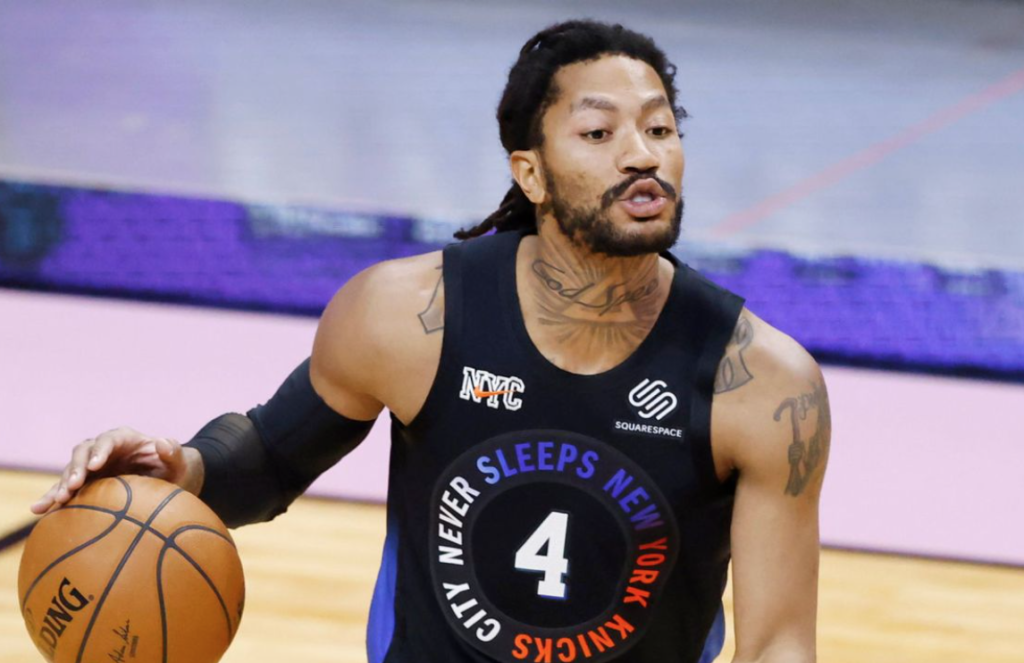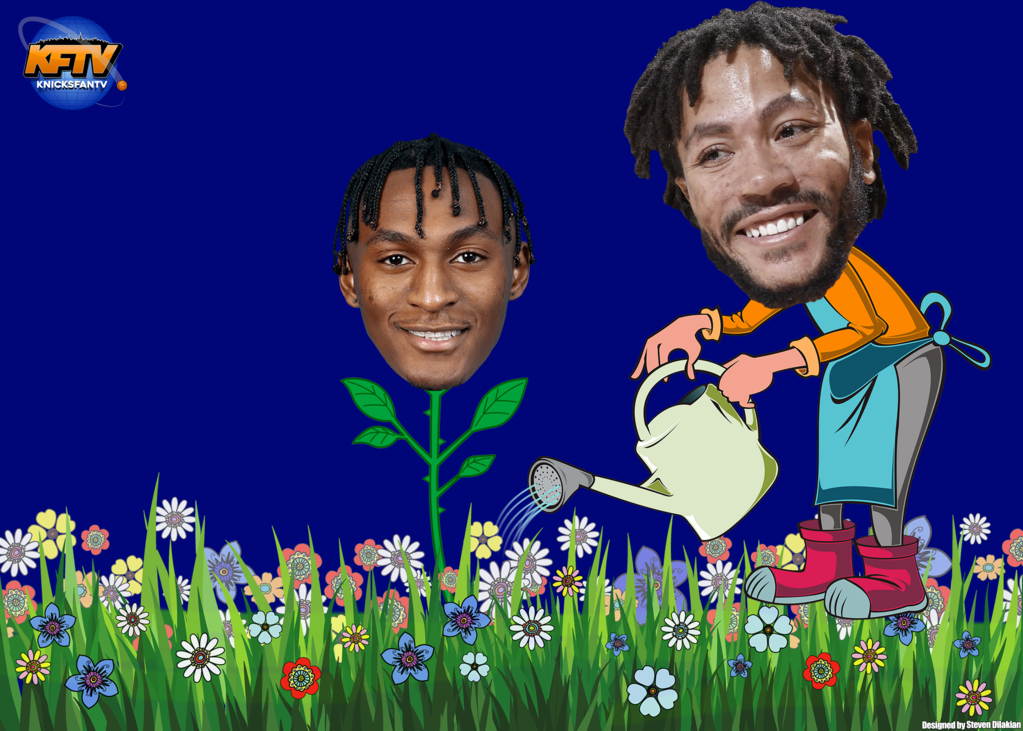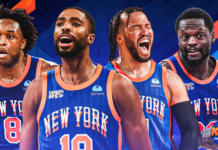The New York Knicks acquired Derrick Rose to improve their point guard play. Also, his presence helps the growth of Immanuel Quickley.
The New York Knicks traded for Derrick Rose… again. But this time around, Rose has been a key contributor to New York’s success. Watching the Knicks now before they traded for Rose is like going from black and white to technicolor. It’s just a different experience.
We saw the immediate impact Rose made in his second debut in the orange and blue when they played the Miami Heat. He’s given New York another facilitator and scorer who helps push the pace and space the floor, which was surely missing. Since the Knicks traded for Rose, New York is 7-3 in the ten games he’s played. Unfortunately, Rose missed the last two games before the All-Star break due to inconclusive COVID testing, but at least the Knicks secured the dub against the Pistons.
Now, it’s a small sample size that we have of D-Rose on the Knickerbockers thus far. But there are signs that he will be a significant factor for this team’s overall success this season and the development of Immanuel Quickley. Remember, the Knicks had a win-loss record of 11-14 before trading for Rose, and they’re currently 19-18 and fifth in the Eastern Conference. On top of that, we’ve seen Quickley operate more efficiently and effectively with Rose on the team – Quickley’s net rating jumped from 0.7 to 5.4 since Rose joined.

Now don’t get it twisted. Rose isn’t and won’t be the sole reason for the Knickerbockers’ success. Julius Randle’s emergence as an All-Star, RJ Barrett’s noticeable improvements, Immanuel Quickley’s emergence, and Mitchell Robinson’s growth defensively (even though he is still injured) will all be critical factors for the Knicks making so much noise this season. Another critical contributing factor: Tom Thibodeau and a coaching staff that has established a culture of team basketball, accountability, and hard work.
With that said, Rose has been crucial for the Knicks to this point and will continue to be as the franchise heads into the second half of this season.
What does Derrick Rose bring to the Knicks?
Rose isn’t the 2011 NBA MVP that he once was on the Chicago Bulls when he averaged 25 points, 7.7 assists, and 4.1 rebounds with a .445/.332/.858 slash line. But in no way does that mean he still doesn’t have an impact on the court. Some believed that Rose couldn’t be a difference-maker anymore because his past stops were on teams that were non-competitive (the Minnesota Timberwolves & Detroit Pistons). Between Rose’s time on both teams, the win-loss total was 61-110 (this record is excluding the nine games he played with Minnesota during the 2017-18 season because he didn’t play an entire season with the team, making the sample size too small).
Even though Rose’s time with both franchises didn’t translate to success, it didn’t mean that he wasn’t a productive player. Like his first stint with the Knicks, he maintained high counting stats, but that didn’t translate to a lot of wins. However, we can’t completely blame Rose because both teams’ roster construction was not conducive for consistent success.
Now the Knicks are not infinitely better than Rose’s previous teams, but they are a more balanced team with similar (and arguably slightly more) talent.
As we’ve seen Derrick play through ten games, he’s brought a slightly improved offensive game than what we currently had from the point guard position. Not only does he attack the lane, but he’s provided solid shooting and sound defense. Since he’s been with New York, he’s maintained a slash line of .431/.455/.875 while averaging 12.5points, 2.5 rebounds, 4.9 assists, and 1.1 steals during 24.6 minutes per game.
After watching him play, there’s no doubt that he still is crafty and has matured his game. We’ll still see him pull out some old tricks, like when he maneuvers through traffic for a reverse layup as he’s hanging in mid-air. But more often than not, he is looking to find his teammates than hunting for his own shots; and he seems to have a better understanding of how to change pace throughout the game. Also, he’s become a mentor in the process – from guiding Killian Hayes on the Pistons to now helping Quickley and Obi Toppin.
How does Derrick Rose help Immanuel Quickley?
When the Knicks traded for Rose, part of the fanbase was fearful that Rose would take Quickley’s minutes. But that didn’t happen.
Quickley’s minutes shouldn’t have been a concern because he’s a rookie and surpassed other veterans to break the rotation. Also, Thibodeau was praising his shooting before the season started and is well aware that the Knickerbockers lack enough shooters.
Furthermore, Quickley and Toppin are the new front office’s draft picks, so the new executives have a vested interest in making sure they contribute and can be potential core pieces moving forward. And, if we’re being real, Quickley breaking the rotation on a Thibodeau-led team at the beginning of the season should’ve indicated that he’s a lock.
But with Rose on the team, we’ve seen that he’s allowed Quickley to play off-ball and still have opportunities of playing on-ball as well. It’s slightly reminiscent of the Jason Kidd and Raymond Felton backcourt we had back in the 2012-13 season. The purpose of that backcourt was to alleviate either one from primary point guard duties while still optimizing their playmaking and scoring.
The difference here from the Kidd-Felton stint is that Rose was brought in to help alleviate point guard duties from Quickley so that Quickley can still adapt to the NBA, grow as a facilitator, and utilize his off-ball shooting. Also, unlike that 54-win season, this team isn’t built to win a championship now (unless a lot of cards fell in the Knicks’ favor).
With such a small sample size, we’ve seen that having Rose as the facilitator has allowed Quickley to operate more freely and spot up to get his shot off. Because Rose attacks the lane so frequently, he puts a lot of pressure on the defense to protect the paint, creating space for Quickley. And since Rose’s addition, Quickley’s three-point shooting has jumped from 36.3 percent to 40.6 percent.
It makes sense that Quickley’s three-point shooting was down before Rose’s arrival because we witnessed Quickley getting double-teamed as soon as he passed half-court. Opponents’ scouting reports have highlighted Quickley’s lethal shooting, so of course, they were going to try and prevent his three-pointers and floaters.
Now, Quickley has demonstrated that he can navigate double-teams, but his reads aren’t always fluid (as is expected from a rookie). In some instances, he’s actually slowed down the offense. And having Quickley struggle only hinders the Knicks offense, which isn’t ideal for a team ranked 29th in points per game and is trying to make it to the playoffs.
That’s why limiting Quickley to the point guard position this season would hinder his impact on the floor. Furthermore, Quickley doesn’t attack the lane that often, nor is he the best finisher around the rim. And as we know, Thibodeau appreciates a guard that can attack the lane and cause the defense to collapse, and Rose does just that.
Now you may say: Alex, D-Rose doesn’t finish well around the rim either, so what’s the difference? And to your point, you’re correct. According to Cleaning the Glass, Quickley is better at finishing around the rim than Rose. Quickley has completed 58 percent of his shots around the basket (11-19 field goal), while Rose has finished 54 percent of his shots (15-28 field goal).
However, Rose averages 12.1 drives per game and has a 44.6 field goal percentage while doing so. Quickley, on the other hand, averages 7 drives per game and maintains a 39.8 field goal percentage. Even Elfrid Payton is better at attacking the lane since he averages 11.2 drives per game and has a 48.6 field goal percentage.
Even if Rose isn’t the same explosive player who finishes around the rim at a high level, his name and playstyle still hold enough weight where you need to honor him attacking the cup.
But last and certainly not least, another important factor that no metric cannot gauge is the influence that Rose will have on Quickley as a mentor. As spectators, there are many behind-the-scenes moments that we are not privy to that go into development. Soft factors such as film room study sessions, getting dinner together and talking about the game(s), and guidance on preparing for a long season – regardless of whether it’s a 72 or 82 game season. These are moments that are so important to a young athlete’s growth.
We’ve heard of vets that have been impactful for the development of young players. Recently, we had Julius Randle mention how Kobe Bryant influenced him to get a workout session in as soon as the Los Angeles Lakers landed in a city for a game. And that lesson has stuck with Randle forever since and is one of the key moments that has led to his success, especially this season. Those small instances are so important because they can cause a chain reaction to help a player thrive in their career.
Conclusion
As of right now, fans should be cautiously optimistic about the D-Rose trade while enjoying the pleasant surprise of success the Knickerbockers have had this season. Rose isn’t the long-term solution to the Knicks point guard woes, but he is a good stop-gap for a team currently in playoff contention and has a young guard that needs some guidance. Also, since Rose is a free agent at the end of this season and the Knicks traded for him, it wouldn’t be a surprise if Rose returns the following season based on his long-standing relationship with Thibodeau.













